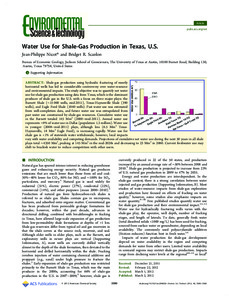Water use for Shale-gas production in Texas, U.S.

Nicot, Jean-Philippe ; Scanlon, Bridget R.
Environmental Science and Technology
2012
46
6
3580-3586
gas ; production ; drilling ; hydraulics
Energy
English
Bibliogr.
"Shale-gas production using hydraulic fracturing of mostly horizontal wells has led to considerable controversy over water-resource and environmental impacts. The study objective was to quantify net water use for shale-gas production using data from Texas, which is the dominant producer of shale gas in the U.S. with a focus on three major plays: the Barnett Shale (~15,000 wells, mid-2011), Texas-Haynesville Shale (390 wells), and Eagle Ford Shale (1040 wells). Past water use was estimated from well-completion data, and future water use was extrapolated from past water use constrained by shale-gas resources. Cumulative water use in the Barnett totaled 145 Mm(3) (2000-mid-2011). Annual water use represents ~9% of water use in Dallas (population 1.3 million). Water use in younger (2008-mid-2011) plays, although less (6.5 Mm(3) Texas-Haynesville, 18 Mm(3) Eagle Ford), is increasing rapidly. Water use for shale gas is <1% of statewide water withdrawals; however, local impacts vary with water availability and competing demands. Projections of cumulative net water use during the next 50 years in all shale plays total ~4350 Mm(3), peaking at 145 Mm(3) in the mid-2020s and decreasing to 23 Mm(3) in 2060. Current freshwater use may shift to brackish water to reduce competition with other users."
Digital
The ETUI is co-funded by the European Union. Views and opinions expressed are however those of the author(s) only and do not necessarily reflect those of the European Union or the ETUI.